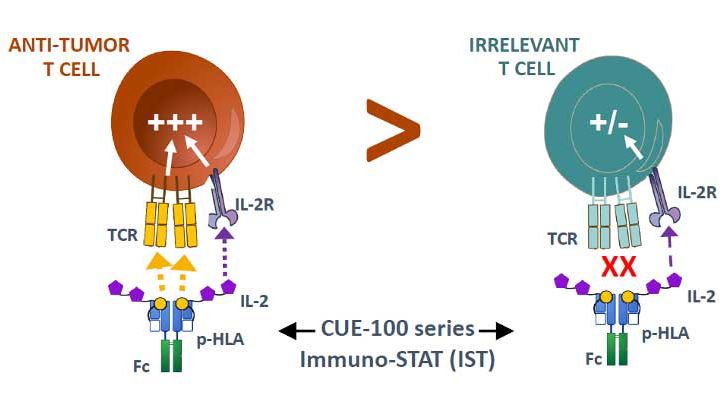What is IL-2, and How is Cue-Biopharma’s IL-2 Molecule Different?
Interleukin-2 (IL-2) is a potent immunostimulant molecule that activates T cells to fight against cancer cells.
Current IL-2 based therapies require high doses of IL-2 to provide a desired clinical effect. Given the small therapeutic window for natural IL-2, this overall leads to minimal therapeutic benefit and common severe adverse events due to indiscriminate activation of T cells against healthy tissue.
Cue Biopharma’s interleukin 2 (IL-2) molecules are engineered with two modifications that maximize activation of tumor specific CD8+ “Killer” T cells and minimize off-target binding to T cells
CD8+ “killer” T cells are a significant subset of immune cells for anti-cancer responses and as such, IL-2 based therapeutics in development aim to activate the relevant members of this cell population to ensure effective cancer killing with an attractive tolerability profile. On the other hand, regulatory CD4+ T cells, also called Tregs, play a suppressive role in the immune response, and if activated, could dampen the benefit of CD8+ T cell activation.
IL-2 activates T cells, both CD8+ as well as CD4+, especially Tregs, through its interaction with different subunits of the IL-2 receptor in T cells (alpha, beta and gamma).
IL-2 receptors have a wide natural range in binding affinities. The high-affinity IL-2 receptor, highly expressed on Tregs, is composed of all 3 subunits. Conversely, most CD8+effector cytotoxic T cells express intermediate affinity beta-gamma subunits of the IL-2 receptor. This means that wild-type, or natural, IL-2 is more likely to bind and activate Tregs over the cytotoxic CD8+ T cells that are best at destroying target cancer cells.
Modifications in Cue Biopharma’s IL-2 Molecules:
- The IL-2 has been engineered to reduce binding to the alpha subunit required for Treg engagement and activation, thereby minimizing the bias for regulatory T cell activation. Accordingly, the predominant effect of IL-2 binding by Immuno-STATs is the activation of cytotoxic CD8+ T cells.
- The IL-2 has also been modified to reduce the binding affinity to the beta subunit of the IL-2 receptor to ensure that the activity of IL-2 is favored to T cells engaged with the Immuno-STAT molecule through Signal#1.
Exploiting TCR and IL-2 Co-engagement to Selectively Activate
Tumor-specific T cells


